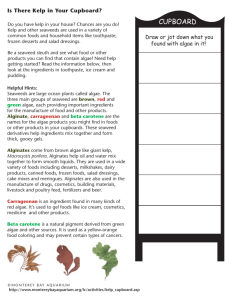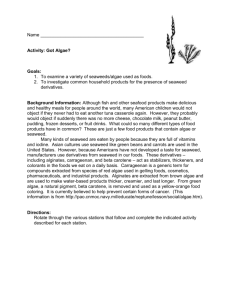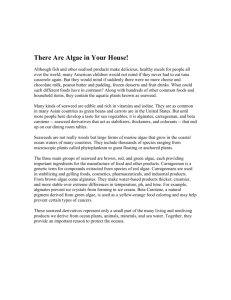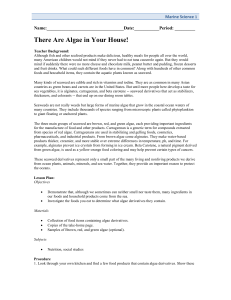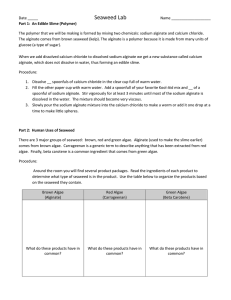Activity: Algae Derivatives
advertisement
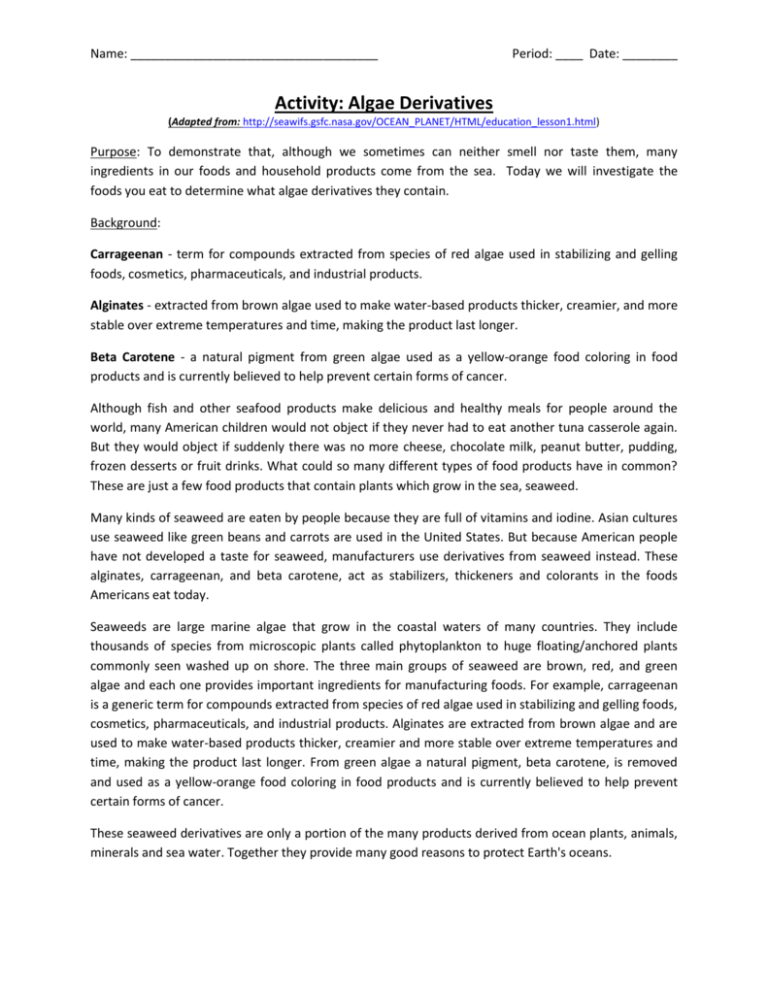
Name: ____________________________________ Period: ____ Date: ________ Activity: Algae Derivatives (Adapted from: http://seawifs.gsfc.nasa.gov/OCEAN_PLANET/HTML/education_lesson1.html) Purpose: To demonstrate that, although we sometimes can neither smell nor taste them, many ingredients in our foods and household products come from the sea. Today we will investigate the foods you eat to determine what algae derivatives they contain. Background: Carrageenan - term for compounds extracted from species of red algae used in stabilizing and gelling foods, cosmetics, pharmaceuticals, and industrial products. Alginates - extracted from brown algae used to make water-based products thicker, creamier, and more stable over extreme temperatures and time, making the product last longer. Beta Carotene - a natural pigment from green algae used as a yellow-orange food coloring in food products and is currently believed to help prevent certain forms of cancer. Although fish and other seafood products make delicious and healthy meals for people around the world, many American children would not object if they never had to eat another tuna casserole again. But they would object if suddenly there was no more cheese, chocolate milk, peanut butter, pudding, frozen desserts or fruit drinks. What could so many different types of food products have in common? These are just a few food products that contain plants which grow in the sea, seaweed. Many kinds of seaweed are eaten by people because they are full of vitamins and iodine. Asian cultures use seaweed like green beans and carrots are used in the United States. But because American people have not developed a taste for seaweed, manufacturers use derivatives from seaweed instead. These alginates, carrageenan, and beta carotene, act as stabilizers, thickeners and colorants in the foods Americans eat today. Seaweeds are large marine algae that grow in the coastal waters of many countries. They include thousands of species from microscopic plants called phytoplankton to huge floating/anchored plants commonly seen washed up on shore. The three main groups of seaweed are brown, red, and green algae and each one provides important ingredients for manufacturing foods. For example, carrageenan is a generic term for compounds extracted from species of red algae used in stabilizing and gelling foods, cosmetics, pharmaceuticals, and industrial products. Alginates are extracted from brown algae and are used to make water-based products thicker, creamier and more stable over extreme temperatures and time, making the product last longer. From green algae a natural pigment, beta carotene, is removed and used as a yellow-orange food coloring in food products and is currently believed to help prevent certain forms of cancer. These seaweed derivatives are only a portion of the many products derived from ocean plants, animals, minerals and sea water. Together they provide many good reasons to protect Earth's oceans. Name: ____________________________________ Period: ____ Date: ________ Procedure: 1. Each product may or may not contain algae. Look for the following ingredients that come from seaweed: carrageenan, alginates, and beta carotene. 2. Follow the lab sheet, placing an X in the appropriate column if the food product contains these algae derivatives. 3. Go around the room and look at the various items that have been brought in. All of these items contain an algae derivative of some sort. Data Table: Fill in the table below with the observations and hypotheses you make. Product Name 1. 2. 3. 4. 5. 6. 7. 8. 9. 10. Algae? (yes/no) Carrageenan Alginates Beta Carotene Name: ____________________________________ Period: ____ Date: ________ Conclusions: 1. Which algal derivative was most common in the products you looked at today? 2. Which phylum does this derivative come from? 3. What is the common use for this derivative? 4. Choose THREE of the products from your data table and hypothesize why you think this derivative is in each product.
